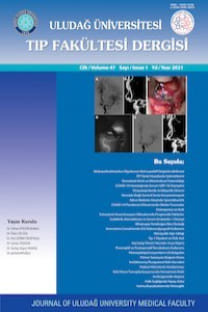Otozomal Dominant Polikistik Böbrek Hastalığında Bilgisayarlı Tomografi Kullanımı
: ODPBH, Nefrolityazis, Bilgisayarlı tomografi, Mayo evrelemesi
Computed Tomography Use in Autosomal Dominant Polycystic Kidney Disease
ADPKD, Nephrolithiasis, Computed tomography, Mayo staging,
___
- 1. Chebib FT, Torres VE: Autosomal Dominant Polycystic Kidney Disease: Core Curriculum 2016. Am J Kidney Dis 2016, 67(5):792-810.
- 2. Müller RU, Benzing T: Management of autosomal-dominant polycystic kidney disease-state-of-the-art. Clin Kidney J 2018, 11(Suppl 1):i2-i13.
- 3. Sharma K, Caroli A, Quach LV, Petzold K, Bozzetto M, Serra AL, Remuzzi G, Remuzzi A: Kidney volume measurement methods for clinical studies on autosomal dominant polycystic kidney disease. PLoS One 2017, 12(5):e0178488.
- 4. Magistroni R, Corsi C, Martí T, Torra R: A Review of the Imaging Techniques for Measuring Kidney and Cyst Volume in Establishing Autosomal Dominant Polycystic Kidney Disease Progression. Am J Nephrol 2018, 48(1):67-78.
- 5. Torres VE, Wilson DM, Hattery RR, Segura JW: Renal stone disease in autosomal dominant polycystic kidney disease. Am J Kidney Dis 1993, 22(4):513-519.
- 6. Bergmann C, Guay-Woodford LM, Harris PC, Horie S, Peters DJM, Torres VE: Polycystic kidney disease. Nat Rev Dis Primers 2018, 4(1):50.
- 7. Levine E, Grantham JJ: Calcified renal stones and cyst calcifications in autosomal dominant polycystic kidney disease: clinical and CT study in 84 patients. AJR Am J Roentgenol 1992, 159(1):77-81.
- 8. Nishiura JL, Neves RF, Eloi SR, Cintra SM, Ajzen SA, Heilberg IP: Evaluation of nephrolithiasis in autosomal dominant polycystic kidney disease patients. Clin J Am Soc Nephrol 2009, 4(4):838-844.
- 9. Torres VE, Chapman AB, Devuyst O, Gansevoort RT, Grantham JJ, Higashihara E, Perrone RD, Krasa HB, Ouyang J, Czerwiec FS: Tolvaptan in patients with autosomal dominant polycystic kidney disease. N Engl J Med 2012, 367(25):2407-2418.
- 10. Nadal Bosch J, Malcolm J, Moya M, Menowsky M, Dominici P: The Importance of Radiologic Imaging Modalities in Autosomal Dominant Polycystic Kidney Disease. Cureus 2022, 14(11):e31480.
- 11. Bargagli M, Dhayat NA, Anderegg M, Semmo M, Huynh-Do U, Vogt B, Ferraro PM, Fuster DG: Urinary Lithogenic Risk Profile in ADPKD Patients Treated with Tolvaptan. Clinical Journal of the American Society of Nephrology 2020, 15(7):1007-1014.
- 12. Hogan MC, Norby SM: Evaluation and management of pain in autosomal dominant polycystic kidney disease. Adv Chronic Kidney Dis 2010, 17(3):e1-e16.
- 13. Eroglu E, Kocyigit I, Cetin M, Zararsiz G, Imamoglu H, Bayramov R, Tastan S, Sipahioglu MH, Tokgoz B, Oymak O: Multiple urinary tract infections are associated with genotype and phenotype in adult polycystic kidney disease. Clinical and Experimental Nephrology 2019, 23(10):1188-1195.
- ISSN: 1300-414X
- Yayın Aralığı: 3
- Başlangıç: 1975
- Yayıncı: Seyhan Miğal
Ayşe SERPİCİ, Neriman AKANSEL, Nursel VATANSEVER, Vahit DALKIZAN
Mehtap EROĞLU, Neşe YAKŞİ, Ümmügülsüm GÜNDOĞDU
Miyelom Zimba Gibi Gelir: Roy Adaptasyon Modeli Bir Olgu Sunumu
Yasemin KARACAN, Hicran YILDIZ, Rıdvan ALİ
Pınar ZORBA BAHÇELİ, Ayşe ARIKAN DÖNMEZ, Gamze ÜNVER, Sevgisun KAPUCU
Yoğun Bakım Hemşirelerinin Alarm Yorgunluğu ve Etkileyen Faktörler
Zeynep KIZILCIK ÖZKAN, Figen DIĞIN, Gökben OSMANLI KARBUZ
Myricetinin LNCaP Androjen Bağımlı Prostat Kanseri Hücreleri Üzerine Etkisinin Araştırılması
Özlem CESUR GÜNAY, Mücahit SEÇME
Covid-19 Enfeksiyonu Sonrası Huzursuz Bacaklar Sendromunun Araştırılması
Pinar UZUN USLU, Duygu ARSLAN MEHDİYEV, Gülgün UNCU, Zeynep ÖZÖZEN AYAS, Yasemin DİNÇ, Aylin BİCAN DEMİR
Sagital Denge ile Multifidus Kas Dejenerasyonu Arası İlişki
Salim MISIRCI, Ali EKİN, Belkıs Nihan COŞKUN, Burcu YAĞIZ, Yavuz PEHLİVAN, Hüseyin Ediz DALKILIÇ
